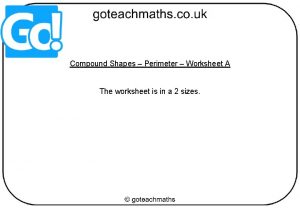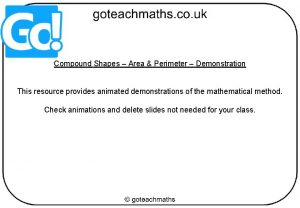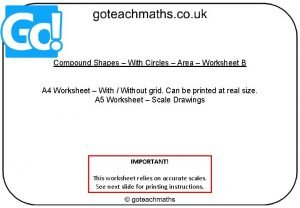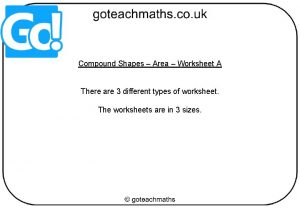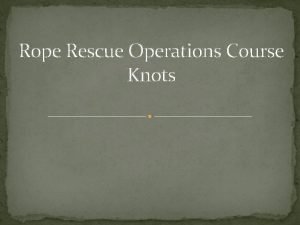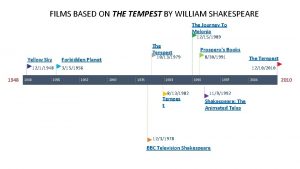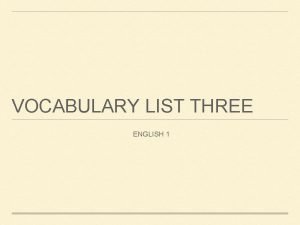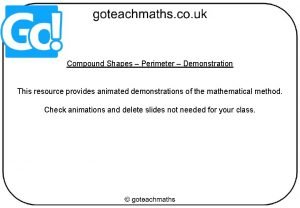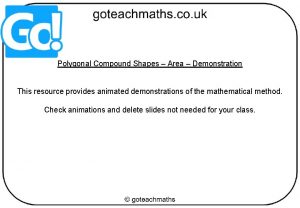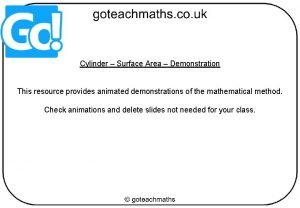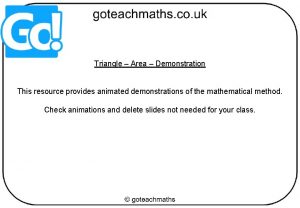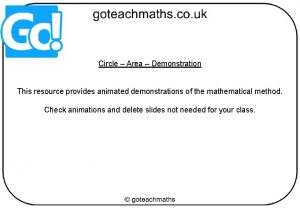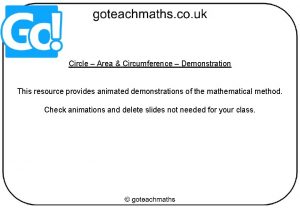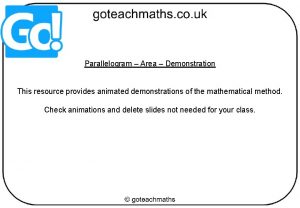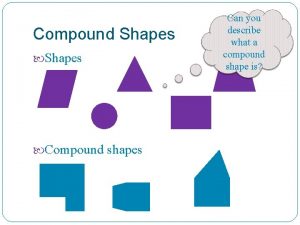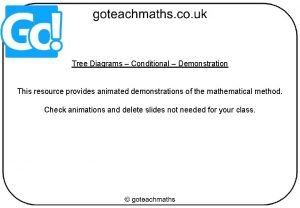Compound Shapes Area Demonstration This resource provides animated
















- Slides: 16

Compound Shapes – Area – Demonstration This resource provides animated demonstrations of the mathematical method. Check animations and delete slides not needed for your class.

These are compound shapes, they are made up of 2 or more rectangles or squares. How would you divide the shapes into parts? overlapping

6 cm How could you calculate the area of this compound shape? Rectangle 1 : 5 cm × 6 cm = 30 cm 2 Rectangle 2 : Rectangle 2 4 cm × 3 cm = 12 cm 2 Total: 30 cm 2 + 12 cm 2 = 42 cm 2 1 cm 2 3 cm

3 cm How could you calculate the area of this compound shape? Rectangle 1 : 5 cm × 3 cm = 15 cm 2 9 cm Rectangle 2 : 9 cm × 3 cm = 27 cm 2 Total: 15 cm 2 + 27 cm 2 = 42 cm 2 1 cm 2 3 cm

2 cm How could you calculate the area of this compound shape? 1 Rectangle 1 : 8 cm × 2 cm = 16 cm 2 8 cm 2 Rectangle 2 : 6 cm × 4 cm = 24 cm 2 6 cm Total: 16 cm 2 + 24 cm 2 = 40 cm 2 1 cm 2 4 cm

How can we find the missing lengths in these diagrams? 2 6 6? 3 9? 8 8? 12 4 (not drawn accurately) 10 7 4? 7

Calculate the area of this compound shape. 1) Divide the compound shape into rectangles. 2) Calculate & label missing lengths. Area: (Add the shape areas) 2 cm 2× 2=4 2× 4=8 2 cm Total = 4 + 8 = 12 cm 2 4 cm 2 cm 4 cm

Calculate the area of this compound shape. 1) Divide the compound shape into rectangles. 2) Calculate & label missing lengths. Area: (Add the shape areas) 5 cm 4 × 5 = 20 2× 2=4 4 cm Total = 20 + 4 = 24 cm 2 6 cm 3 cm 2 cm

Calculate the area of this compound shape. 1) Divide the compound shape into rectangles. 2) Calculate & label missing lengths. Area: (Add the shape areas) 8 × 4 = 32 4 cm 6 × 5 = 30 Total = 32 + 30 = 62 cm 2 3 cm 8 cm 6 cm 5 cm 10 cm

Calculate the area of this compound shape. 1) Divide the compound shape into rectangles. 2) Calculate & label missing lengths. 3 cm Area: (Add the shape areas) 4 × 4 = 16 3 × 9 = 27 Total = 16 + 27 = 43 cm 2 4 cm 7 cm 9 cm

Calculate the area of this compound shape. 1) Divide the compound shape into rectangles. 2) Calculate & label missing lengths. Area: (Add the shape areas) 4 × 5 = 20 4 cm 3 × 10 = 30 Total = 20 + 30 = 50 cm 2 5 cm 2 cm 4 cm 3 cm 10 cm 8 cm

Calculate the area of each compound shape. Area = 27 cm 2 3 cm A) B) Area = 32 cm 2 3 cm 10 cm 3 cm 6 cm 3 cm 2 cm 8 cm 6 cm 8 cm C) 2 cm 9 m D) 9 m 5 cm Area = 25 3 cm cm 2 Area = 57 m 2 3 m 2 m

All these shapes are made from congruent (identical) rectangles. Find the area of each compound shape. Area = 16 cm 2 2 cm Area = 12 cm 2 4 cm Area = 24 cm 2 Area = 18 cm 2 Area = 12 cm 2

All these shapes are made from overlapping congruent rectangles. Find the area of each compound shape. 2 cm 5 cm Area = 22 cm 2 Area = 16 cm 2 1 3 4 4 2 Area = 32 cm 2 Area = 26 cm 2 4


Questions? Comments? Suggestions? …or have you found a mistake!? Any feedback would be appreciated . Please feel free to email: tom@goteachmaths. co. uk
 A shape is made from 3 congruent rectangles
A shape is made from 3 congruent rectangles Find the area of the compound shape
Find the area of the compound shape How to calculate area of shapes
How to calculate area of shapes Compound shapes with circles
Compound shapes with circles Compound shapes worksheet
Compound shapes worksheet Donuts animated
Donuts animated Data flow diagram animation
Data flow diagram animation 3 story bus
3 story bus Animated scene maker
Animated scene maker Tensionless hitch
Tensionless hitch Movies based on the tempest
Movies based on the tempest Animated assembly video
Animated assembly video Plant cell animated
Plant cell animated Animated liquid sunset
Animated liquid sunset Leaving cert lce
Leaving cert lce Outline of social science
Outline of social science Indulge adjective
Indulge adjective
